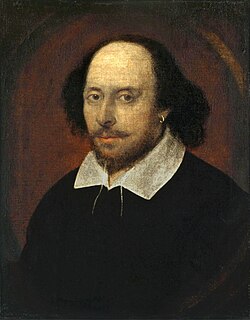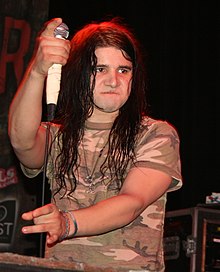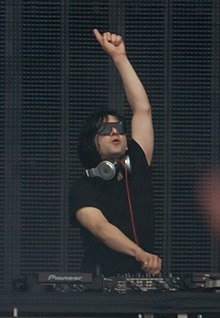Bill Gates
For other people named Bill Gates, see Bill Gates (disambiguation).

Bill Gates

Gates in 2012.
Born William Henry Gates III
October 28, 1955 (age 57)
Seattle, WA, US
Residence Medina, WA, US
Nationality American
Alma mater Harvard University
(dropped out)
Occupation Co-founder and Chairman ofMicrosoft
Co-Chair of the Bill & Melinda Gates Foundation
CEO of Cascade Investment
Chairman of Corbis
Years active 1975–present
Net worth
 US$ 72.7 billion (2013)[1]
US$ 72.7 billion (2013)[1]Board member of
Berkshire Hathaway
Spouse(s) Melinda Gates (1994–present)
Children 3
Parents William H. Gates, Sr.
Mary Maxwell Gates
Signature

Website
The Gates Notes
William Henry "Bill" Gates III (born October 28, 1955)[2] is an American business magnate, investor, programmer,[3] inventor[4] and philanthropist. Gates is the former chief executive and current chairman of Microsoft, the world’s largest personal-computer software company, which he co-founded with Paul Allen.
He is consistently ranked in the Forbes list of the world's wealthiest people[5] and was the wealthiest overall from 1995 to 2009—excluding 2008, when he was ranked third;[6] in 2011 he was the wealthiest American and the world's second wealthiest person.[7][8] According to the Bloomberg Billionaires List, Gates is the world's richest person in 2013, a position that he last held on the list in 2007.[1]
During his career at Microsoft, Gates held the positions of CEO and chief software architect, and remains the largest individual shareholder, with 6.4 percent of the common stock.[a] He has also authored and co-authored several books.
Gates is one of the best-known entrepreneurs of the personal computer revolution. Gates has been criticized for his business tactics, which have been considered anti-competitive, an opinion which has in some cases been upheld by the courts.[11][12] In the later stages of his career, Gates has pursued a number of philanthropic endeavors, donating large amounts of money to various charitable organizations and scientific research programs through the Bill & Melinda Gates Foundation, established in 2000.[13]
Gates stepped down as chief executive officer of Microsoft in January 2000. He remained as chairman and created the position of chief software architect. In June 2006, Gates announced that he would be transitioning from full-time work at Microsoft to part-time work, and full-time work at the Bill & Melinda Gates Foundation. He gradually transferred his duties to Ray Ozzie, chief software architect, and Craig Mundie, chief research and strategy officer. Gates's last full-time day at Microsoft was June 27, 2008. He remains at Microsoft as non-executive chairman.
Contents [hide]
1 Early life
2 Microsoft
2.1 BASIC
2.2 IBM partnership
2.3 Windows
2.4 Management style
2.5 Antitrust litigation
2.6 Appearance in ads
3 Post-Microsoft
4 Personal life
4.1 Philanthropy
4.2 Recognition
4.3 Investments
5 Books and films
6 See also
7 Notes
8 References
8.1 Bibliography
9 Further reading
10 External links
Early life
Gates was born in Seattle, Washington, to William H. Gates, Sr. and Mary Maxwell Gates. His ancestry includes English, German, and Scots-Irish.[14][15] His father was a prominent lawyer, and his mother served on the board of directors for First Interstate BancSystem and the United Way. Gates's maternal grandfather was JW Maxwell, a national bank president. Gates has one elder sister, Kristi (Kristianne), and one younger sister, Libby. He was the fourth of his name in his family, but was known as William Gates III or "Trey" because his father had the "II" suffix.[16] Early on in his life, Gates's parents had a law career in mind for him.[17] When Gates was young, his family regularly attended a Congregational church.[18][19][20]
At 13 he enrolled in the Lakeside School, an exclusive preparatory school.[21] When he was in the eighth grade, the Mothers Club at the school used proceeds from Lakeside School's rummage sale to buy a Teletype Model 33 ASR terminal and a block of computer time on a General Electric (GE) computer for the school's students.[22] Gates took an interest in programming the GE system in BASIC, and was excused from math classes to pursue his interest. He wrote his first computer program on this machine: an implementation of tic-tac-toe that allowed users to play games against the computer. Gates was fascinated by the machine and how it would always execute software code perfectly. When he reflected back on that moment, he said, "There was just something neat about the machine."[23] After the Mothers Club donation was exhausted, he and other students sought time on systems including DEC PDP minicomputers. One of these systems was a PDP-10 belonging to Computer Center Corporation (CCC), which banned four Lakeside students—Gates, Paul Allen, Ric Weiland, and Kent Evans—for the summer after it caught them exploiting bugs in the operating system to obtain free computer time.[24][25]
At the end of the ban, the four students offered to find bugs in CCC's software in exchange for computer time. Rather than use the system via Teletype, Gates went to CCC's offices and studiedsource code for various programs that ran on the system, including programs in Fortran, Lisp, and machine language. The arrangement with CCC continued until 1970, when the company went out of business. The following year, Information Sciences, Inc. hired the four Lakeside students to write a payroll program in Cobol, providing them computer time and royalties. After his administrators became aware of his programming abilities, Gates wrote the school's computer program to schedule students in classes. He modified the code so that he was placed in classes with mostly female students. He later stated that "it was hard to tear myself away from a machine at which I could so unambiguously demonstrate success."[23] At age 17, Gates formed a venture with Allen, called Traf-O-Data, to make traffic counters based on the Intel 8008 processor.[26] In early 1973, Bill Gates served as a congressional page in the US House of Representatives.[27]
Gates graduated from Lakeside School in 1973. He scored 1590 out of 1600 on the SAT[28] and enrolled at Harvard College in the autumn of 1973.[29] While at Harvard, he met Steve Ballmer, who later succeeded Gates as CEO of Microsoft.

 The Poker Room in Currier House atHarvard University, where Gates and Allen formed Microsoft
The Poker Room in Currier House atHarvard University, where Gates and Allen formed MicrosoftIn his sophomore year, Gates devised an algorithm for pancake sorting as a solution to one of a series of unsolved problems[30] presented in acombinatorics class by Harry Lewis, one of his professors. Gates's solution held the record as the fastest version for over thirty years;[30][31] its successor is faster by only one percent.[30] His solution was later formalized in a published paper in collaboration with Harvard computer scientistChristos Papadimitriou.[32]
Gates did not have a definite study plan while a student at Harvard[33] and spent a lot of time using the school's computers. Gates remained in contact with Paul Allen, and he joined him at Honeywell during the summer of 1974.[34] The following year saw the release of the MITS Altair 8800 based on theIntel 8080 CPU, and Gates and Allen saw this as the opportunity to start their own computer software company.[35] Gates dropped out of Harvard at this time.[36] He had talked this decision over with his parents, who were supportive of him after seeing how much Gates wanted to start a company.[33]
Microsoft
Main articles: History of Microsoft and Microsoft
BASIC
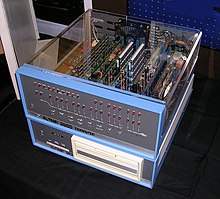
 MITS Altair 8800 Computer with 8-inch (200 mm) floppy disk system
MITS Altair 8800 Computer with 8-inch (200 mm) floppy disk systemAfter reading the January 1975 issue of Popular Electronics that demonstrated the Altair 8800, Gates contacted Micro Instrumentation and Telemetry Systems (MITS), the creators of the new microcomputer, to inform them that he and others were working on a BASIC interpreter for the platform.[37] In reality, Gates and Allen did not have an Altair and had not written code for it; they merely wanted to gauge MITS's interest. MITS president Ed Robertsagreed to meet them for a demo, and over the course of a few weeks they developed an Altair emulator that ran on a minicomputer, and then the BASIC interpreter. The demonstration, held at MITS's offices in Albuquerque was a success and resulted in a deal with MITS to distribute the interpreter asAltair BASIC. Paul Allen was hired into MITS,[38] and Gates took a leave of absence from Harvard to work with Allen at MITS in Albuquerque in November 1975. They named their partnership "Micro-Soft" and had their first office located in Albuquerque.[38] Within a year, the hyphen was dropped, and on November 26, 1976, the trade name "Microsoft" was registered with the Office of the Secretary of the State of New Mexico.[38] Gates never returned to Harvard to complete his studies.
Microsoft's BASIC was popular with computer hobbyists, but Gates discovered that a pre-market copy had leaked into the community and was being widely copied and distributed. In February 1976, Gates wrote an Open Letter to Hobbyists in the MITS newsletter saying that MITS could not continue to produce, distribute, and maintain high-quality software without payment.[39] This letter was unpopular with many computer hobbyists, but Gates persisted in his belief that software developers should be able to demand payment. Microsoft became independent of MITS in late 1976, and it continued to develop programming language software for various systems.[38] The company moved from Albuquerque to its new home in Bellevue, Washington on January 1, 1979.[37]
During Microsoft's early years, all employees had broad responsibility for the company's business. Gates oversaw the business details, but continued to write code as well. In the first five years, Gates personally reviewed every line of code the company shipped, and often rewrote parts of it as he saw fit.[40]
IBM partnership
IBM approached Microsoft in July 1980 regarding its upcoming personal computer, the IBM PC.[41] The computer company first proposed that Microsoft write the BASIC interpreter. When IBM's representatives mentioned that they needed an operating system, Gates referred them to Digital Research (DRI), makers of the widely used CP/M operating system.[42] IBM's discussions with Digital Research went poorly, and they did not reach a licensing agreement. IBM representative Jack Sams mentioned the licensing difficulties during a subsequent meeting with Gates and told him to get an acceptable operating system. A few weeks later Gates proposed using 86-DOS (QDOS), an operating system similar to CP/M that Tim Paterson of Seattle Computer Products(SCP) had made for hardware similar to the PC. Microsoft made a deal with SCP to become the exclusive licensing agent, and later the full owner, of 86-DOS. After adapting the operating system for the PC, Microsoft delivered it to IBM as PC-DOS in exchange for a one-time fee of $50,000.[43]
Gates did not offer to transfer the copyright on the operating system, because he believed that other hardware vendors would clone IBM's system.[43] They did, and the sales of MS-DOS made Microsoft a major player in the industry.[44] Despite IBM's name on the operating system the press quickly identified Microsoft as being very influential on the new computer, with PC Magazineasking if Gates were "The Man Behind The Machine?"[41] He oversaw Microsoft's company restructuring on June 25, 1981, which re-incorporated the company in Washington state and made Gates President of Microsoft and the Chairman of the Board.[37]
Windows
Microsoft launched its first retail version of Microsoft Windows on November 20, 1985, and in August, the company struck a deal with IBM to develop a separate operating system called OS/2. Although the two companies successfully developed the first version of the new system, mounting creative differences caused the partnership to deteriorate. It ended in 1991, when Gates led Microsoft to develop a version of OS/2 independently from IBM.[45]
Management style
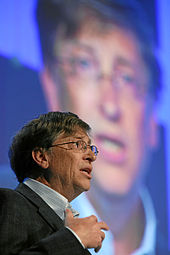
 Bill Gates in January 2008
Bill Gates in January 2008From Microsoft's founding in 1975 until 2006, Gates had primary responsibility for the company's product strategy. He aggressively broadened the company's range of products, and wherever Microsoft achieved a dominant position he vigorously defended it. He gained a reputation for being distant to others; as early as 1981 an industry executive complained in public that "Gates is notorious for not being reachable by phone and for not returning phone calls."[46] Another executive recalled that after he showed Gates a videogame and defeated him 35 of 37 times, when they met again a month later Gates "won or tied every game. He had studied the game until he solved it. That is a competitor."[47]
As an executive, Gates met regularly with Microsoft's senior managers and program managers. Firsthand accounts of these meetings describe him as verbally combative, berating managers for perceived holes in their business strategies or proposals that placed the company's long-term interests at risk.[48][49]
He often interrupted presentations with such comments as, "That's the stupidest thing I've ever heard!"[50] and, "Why don't you just give up your options and join the Peace Corps?"[51] The target of his outburst then had to defend the proposal in detail until, hopefully, Gates was fully convinced.[50] When subordinates appeared to be procrastinating, he was known to remark sarcastically, "I'll do it over the weekend."[52][53][54]
Gates's role at Microsoft for most of its history was primarily a management and executive role. However, he was an active software developer in the early years, particularly on the company's programming language products. He has not officially been on a development team since working on the TRS-80 Model 100,[55] but wrote code as late as 1989 that shipped in the company's products.[53] On June 15, 2006, Gates announced that he would transition out of his day-to-day role over the next two years to dedicate more time to philanthropy. He divided his responsibilities between two successors, placing Ray Ozzie in charge of day-to-day management and Craig Mundie in charge of long-term product strategy.[56]
Antitrust litigation
Further information: United States Microsoft antitrust case and European Union Microsoft competition case

 Gates giving his deposition at Microsoft on August 27, 1998
Gates giving his deposition at Microsoft on August 27, 1998Many decisions that led to antitrust litigation over Microsoft's business practices have had Gates's approval. In the 1998 United States v. Microsoft case, Gates gave deposition testimony that several journalists characterized as evasive. He argued with examiner David Boies over the contextual meaning of words such as, "compete", "concerned", and "we". The judge and other observers in the court room were seen laughing at various points during the deposition.[57] BusinessWeek reported:
Early rounds of his deposition show him offering obfuscatory answers and saying 'I don't recall,' so many times that even the presiding judge had to chuckle. Worse, many of the technology chief's denials and pleas of ignorance were directly refuted by prosecutors with snippets of e-mail that Gates both sent and received.[58]
Gates later said he had simply resisted attempts by Boies to mischaracterize his words and actions. As to his demeanor during the deposition, he said, "Did I fence with Boies? ... I plead guilty. Whatever that penalty is should be levied against me: rudeness to Boies in the first degree."[59] Despite Gates' denials, the judge ruled that Microsoft had committed monopolization and tying, and blocking competition, both in violation of the Sherman Antitrust Act.[59]
Appearance in ads

 Gates mugshot of his 1977 arrest in New Mexico
Gates mugshot of his 1977 arrest in New MexicoGates appeared in a series of ads to promote Microsoft in 2008. The first commercial, co-starring Jerry Seinfeld, is a 90-second talk between strangers as Seinfeld walks up on a discount shoe store (Shoe Circus) in a mall and notices Gates buying shoes inside. The salesman is trying to sell Mr. Gates shoes that are a size too big. As Gates is buying the shoes, he holds up his discount card, which uses a slightly altered version of his own mugshot of his arrest in New Mexico in 1977 for a traffic violation.[60] As they are walking out of the mall, Seinfeld asks Gates if he has melded his mind to other developers, after getting a yes, he then asks if they are working on a way to make computers edible, again getting a yes. Some say that this is an homage to Seinfeld's own show about "nothing" (Seinfeld).[61] In a second commercial in the series, Gates and Seinfeld are at the home of an average family trying to fit in with normal people.
Post-Microsoft
Since leaving day-to-day operations at Microsoft (where he remains Chairman[62]), Gates continues his philanthropy and, among other projects, purchased the video rights to the Messenger Lectures series called The Character of Physical Law, given at Cornell University by Richard Feynman in 1964 and recorded by theBBC. The videos are available online to the public at Microsoft's Project Tuva.[63][64]
In April 2010, Gates was invited to visit and speak at the Massachusetts Institute of Technology where he asked the students to take on the hard problems of the world in their futures.[65][66]
Personal life
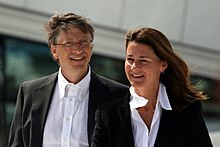
 Bill and Melinda Gates, June 2009
Bill and Melinda Gates, June 2009Gates married Melinda French on January 1, 1994. They have three children: daughters Jennifer Katharine (b. 1996) and Phoebe Adele (b. 2002), and son Rory John (b. 1999). The family resides in the Gates's home, an earth-sheltered house in the side of a hill overlooking Lake Washington in Medina. According to King County public records, as of 2006 the total assessed value of the property (land and house) is $125 million, and the annual property tax is $991,000.
Gates's 66,000 sq ft (6,100 m2) estate has a 60-foot (18 m) swimming pool with an underwater music system, as well as a 2,500 sq ft (230 m2) gym and a 1,000 sq ft (93 m2) dining room.[67]
Also among Gates's private acquisitions is the Codex Leicester, a collection of writings by Leonardo da Vinci, which Gates bought for $30.8 million at an auction in 1994.[68] Gates is also known as an avid reader, and the ceiling of his large home library is engraved with a quotation from The Great Gatsby.[69] He also enjoys playing bridge, tennis, and golf.[70][71]
Gates was number one on the Forbes 400 list from 1993 through to 2007 and number one on Forbes list of The World's Richest People from 1995 to 2007 and 2009. In 1999, his wealth briefly surpassed $101 billion, causing the media to call Gates a "centibillionaire".[72] Despite his wealth and extensive business travel Gates usually flew coachuntil 1997, when he bought a private jet.[73] Since 2000, the nominal value of his Microsoft holdings has declined due to a fall in Microsoft's stock price after the dot-com bubble burst and the multi-billion dollar donations he has made to his charitable foundations. In a May 2006 interview, Gates commented that he wished that he were not the richest man in the world because he disliked the attention it brought.[74] In March 2010, Gates was the second wealthiest person behind Carlos Slim, but regained the top position in 2013 according to the Bloomberg Billionaires List.[1]
Gates has several investments outside Microsoft, which in 2006 paid him a salary of $616,667 and $350,000 bonus totalling $966,667.[75] He founded Corbis, a digital imaging company, in 1989. In 2004 he became a director of Berkshire Hathaway, the investment company headed by long-time friend Warren Buffett.[76]
Philanthropy

 Gates with Bono, Queen Rania of Jordan, former British Prime Minister Gordon Brown, President Umaru Yar'Adua of Nigeria and others during the Annual Meeting 2008 of the World Economic Forum in Switzerland
Gates with Bono, Queen Rania of Jordan, former British Prime Minister Gordon Brown, President Umaru Yar'Adua of Nigeria and others during the Annual Meeting 2008 of the World Economic Forum in SwitzerlandFurther information: Bill & Melinda Gates Foundation
Gates began to appreciate the expectations others had of him when public opinion mounted suggesting that he could give more of his wealth to charity. Gates studied the work of Andrew Carnegie and John D. Rockefeller, and in 1994 sold some of his Microsoft stock to create the William H. Gates Foundation. In 2000, Gates and his wife combined three family foundations into one to create the charitable Bill & Melinda Gates Foundation, which is the largest transparently operated charitable foundation in the world.[77] The foundation allows benefactors access to information regarding how its money is being spent, unlike other major charitable organizations such as the Wellcome Trust.[78][79] The generosity and extensive philanthropy of David Rockefeller has been credited as a major influence. Gates and his father met with Rockefeller several times, and modeled their giving in part on theRockefeller family's philanthropic focus, namely those global problems that are ignored by governments and other organizations.[80] As of 2007, Bill and Melinda Gates were the second-most generous philanthropists in America, having given over $28 billion to charity;[81] the couple plan to eventually donate 95% of their wealth to charity.[82]
The foundation was at the same time criticized because it invests assets that it has not yet distributed with the exclusive goal of maximizing return on investment. As a result, its investments include companies that have been charged with worsening poverty in the same developing countries where the Foundation is attempting to relieve poverty. These include companies that pollute heavily, and pharmaceutical companies that do not sell into the developing world.[83] In response to press criticism, the foundation announced in 2007 a review of its investments, to assess social responsibility.[84] It subsequently canceled the review and stood by its policy of investing for maximum return, while using voting rights to influence company practices.[85] The Gates Millennium Scholars program has been criticized for its exclusion ofCaucasian students.[86][87]
Gates's wife urged people to learn a lesson from the philanthropic efforts of the Salwen family, which had sold its home and given away half of its value, as detailed in The Power of Half.[88] Gates and his wife invited Joan Salwen to Seattle to speak about what the family had done, and on December 9, 2010, Gates, investor Warren Buffett, and Mark Zuckerberg (Facebook's CEO) signed a promise they called the "Gates-Buffet Giving Pledge", in which they promised to donate to charity at least half of their wealth over the course of time.[89][90][91]
In March 2013, Bill Gates offered a US$100,000 grant through his foundation for a condom design that "significantly preserves or enhances pleasure" to encourage more males to adopt the use of condoms for safer sex. The grant information states: “The primary drawback from the male perspective is that condoms decrease pleasure as compared to no condom, creating a trade-off that many men find unacceptable, particularly given that the decisions about use must be made just prior to intercourse. Is it possible to develop a product without this stigma, or better, one that is felt to enhance pleasure?”.[92]
Recognition
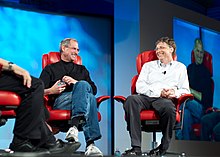
 Gates and Steve Jobs at the 5thD: All Things Digital conference (D5) in 2007
Gates and Steve Jobs at the 5thD: All Things Digital conference (D5) in 2007In 1987, Gates was listed as a billionaire in the pages of Forbes' 400 Richest People in America issue, just days before his 32nd birthday. As the world's youngest self-made billionaire, he was worth $1.25 billion, over $900 million more than he'd been worth the year before, when he'd debuted on the list.[93]
Time magazine named Gates one of the 100 people who most influenced the 20th century, as well as one of the 100 most influential people of 2004, 2005, and 2006. Time also collectively named Gates, his wife Melinda and U2's lead singer Bono as the 2005 Persons of the Year for their humanitarian efforts.[94] In 2006, he was voted eighth in the list of "Heroes of our time".[95] Gates was listed in the Sunday Times power list in 1999, named CEO of the year by Chief Executive Officers magazine in 1994, ranked number one in the "Top 50 Cyber Elite" by Time in 1998, ranked number two in theUpside Elite 100 in 1999 and was included in The Guardian as one of the "Top 100 influential people in media" in 2001.[96]
In 1994, he was honoured as the twentieth Distinguished Fellow of the British Computer Society. Gates has received honorary doctorates from Nyenrode Business Universiteit, Breukelen, The Netherlands, in 2000;[97] the Royal Institute of Technology, Stockholm, Sweden, in 2002;[98] Waseda University, Tokyo, Japan, in 2005; Tsinghua University, Beijing, China, in April 2007;[99] Harvard University in June 2007;[100] the Karolinska Institutet, Stockholm, in January 2008,[101] and Cambridge University in June 2009.[102] He was also made an honorary trustee of Peking University in 2007.[103] Gates was also made an honorary Knight Commander of the Order of the British Empire (KBE) by Queen Elizabeth II in 2005,[104] in addition to having entomologists name the Bill Gates flower fly, Eristalis gatesi, in his honor.[105]
In November 2006, he and his wife were awarded the Order of the Aztec Eagle for their philanthropic work around the world in the areas of health and education, particularly in Mexico, and specifically in the program "Un país de lectores".[106] In October 2009, it was announced that Gates will be awarded the 2010 Bower Award for Business Leadership of The Franklin Institute for his achievements in business and for his philanthropic work.[citation needed] In 2010 he was honored with the Silver Buffalo Award by the Boy Scouts of America, its highest award for adults, for his service to youth.[107]
In 2011, Bill Gates was ranked as the fifth most powerful person in the world, according to Forbes magazine.[108]
Investments
Cascade Investments LLC, a private investment and holding company, incorporated in United States, is controlled by Bill Gates, and is headquartered in the city of Kirkland, Washington.
bgC3, a new think-tank company founded by Bill Gates.
Corbis, a digital image licensing and rights services company.
TerraPower, a nuclear reactor design company.
Books and films
To date, Bill Gates has authored two books:The Road Ahead, written with Microsoft executive Nathan Myhrvold and journalist Peter Rinearson, was published in November 1995. It summarized the implications of the personal computing revolution and described a future profoundly changed by the arrival of a global information superhighway.Business @ the Speed of Thought was published in 1999, and discusses how business and technology are integrated, and shows how digital infrastructures and information networks can help getting an edge on the competition.
Gates has appeared in a number of documentaries, including the 2010 documentary film Waiting for "Superman",[109] and the BBC documentary series The Virtual Revolution.
Gates was prominently featured in Pirates of Silicon Valley, a 1999 film which chronicles the rise of Apple and Microsoft from the early 1970s to 1997. He was portrayed by Anthony Michael Hall.
